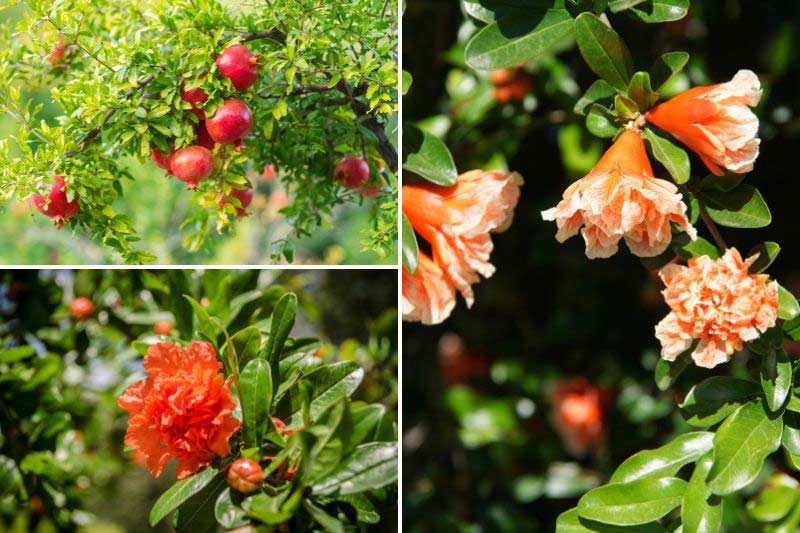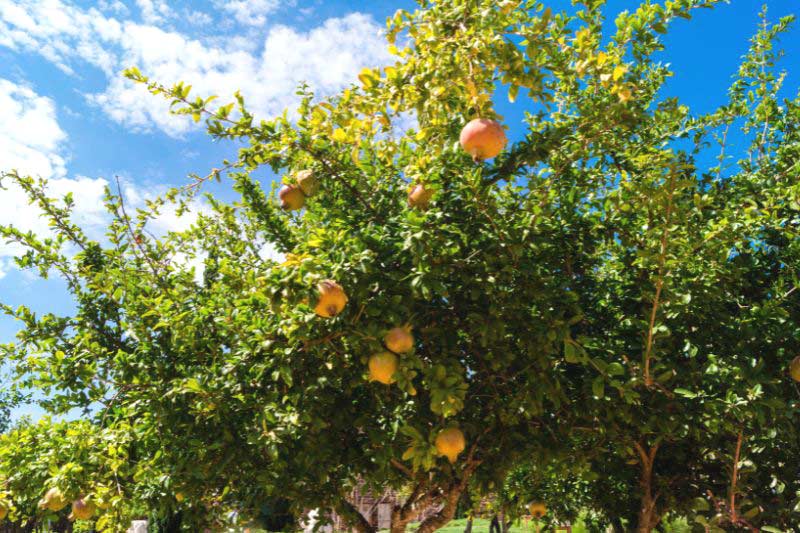Pruning the pomegranate tree (Punica granatum) is an essential action to promote its vigour, flowering and fruiting. This small Mediterranean fruit tree is popular for its abundant red, glossy, juicy fruits. Its ornamental qualities are also much appreciated in gardens, with its very decorative crumpled flowers – single or double – in bright orangey-red or variegated salmon tones depending on variety. They are highlighted by shiny bright green foliage and a compact, dense habit. Heat-loving and very drought-tolerant, the fruiting pomegranate needs a long, hot summer to ripen its fine pomegranates, but there are also sterile varieties that do not produce fruit: flowering pomegranates.
In this tutorial, we will explain when to prune a pomegranate tree, and how to prune a flowering or fruiting pomegranate to get the best results.
And discover our complete range of pomegranates

Pomegranate: fruit extremely rich in antioxidants
Pomegranate, fruit of the pomegranate tree, is a fleshy berry with a leathery skin, containing dozens of juicy seeds called arils. Very decorative and delicious, it is also known for many virtues: rich in antioxidants and vitamins C and K, it is valued for its health benefits. It is eaten fresh, juiced, or used in sweet-and-savoury cooking.
Why prune pomegranate trees?
There are several reasons why it may be necessary to prune a pomegranate tree:
- Control size and shape: pomegranate trees can grow quite quickly and become rather cumbersome, so pruning may be necessary to control them and keep them at desired size. This pruning also helps maintain desired form and structure of your bush.
- Stimulate flowering: annual prunings encourage abundant flowering by improving air and light circulation through plant.
- Stimulate fruit production: by pruning pomegranates judiciously, it is possible to encourage additional fruit production.
- Maintain bush health: by removing dead or diseased parts, pruning can help prevent spread of disease and pests and encourage healthy, vigorous growth.
When to prune pomegranate trees?
It is generally recommended to prune pomegranate trees in early spring, at start of the growth season. Pruning period depends partly on climate zone where plant is located; it is usually between mid-February and mid-March.
How to prune a pomegranate?
- With a pruning shear and/or loppers, well sharpened and pre-disinfected with alcohol to avoid transmission of disease, remove dead, diseased or damaged branches
- Let pomegranate develop freely during first years after planting, then you can select 5–6 main branches to give it an airy, balanced shape and prune back excess branches to maintain desired form of plant
- If you leave it to a free form, it will have a somewhat untidy bushy habit. You can simply remove suckers, crossing wood and dead wood. If you want to encourage growth of new branches, cut the oldest and thickest back to about one-third of their length
- To encourage flowering and pomegranate production, prune branches to encourage branching and new shoots: leave two to four buds on each branch.

- During fruiting, avoid leaving more than three to five pomegranates per branch to prevent overloading and thus favour production of quality fruit.

What tools for pruning a pomegranate?
To prune your pomegranate tree, you will need:
- gardening gloves to protect hands during pruning
- a pruning shear and loppers well sharpened
- a spray bottle of alcohol, useful for disinfecting cutting tools
































Comments